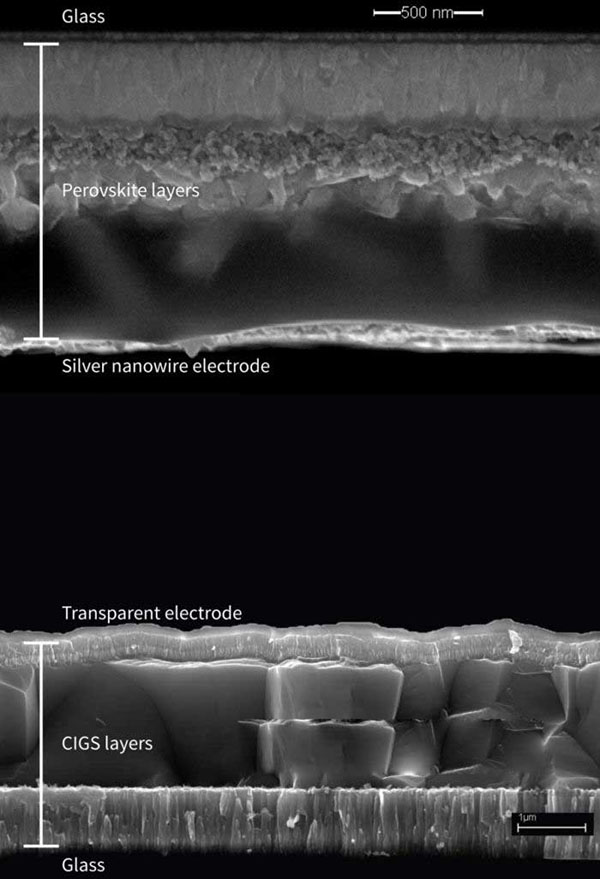
Cross-sections of two solar cells glued together. Perovskite solar cells, CIGS solar cells
Researchers at Stanford University in the United States have found that conversion efficiency can be effectively improved by stacking perovskite solar cells (perovskite solar cells) on existing solar cells. Related papers have been published in the academic journal Energy & Environmental Science. The paper points out that this technology can improve the conversion efficiency of silicon solar cells and CIGS solar cells at low cost.
A perovskite material refers to a crystal structure (perovskite structure) material having the chemical formula ABX3 of 3 elements or molecules (A, B, X). A constitutes a cubic crystal, X is located in the center of each face of the cubic crystal, forming an octahedron, and B is located in the center of the cube and the octahedron. Since A and B are mostly transition metals, and X is mostly an oxygen atom, it is also referred to as ABO3. Among them, the "first ancestor" of calcium perovskite material (CaTiO3) is a typical example of this structural material.
Recently, the technology of using perovskite materials on solar cells has attracted attention. This is because the conversion efficiency of perovskite-sensitized solar cells using perovskite materials in the "pigment" portion of dye-sensitized solar cells has rapidly increased in the last five years, and the conversion efficiency of some developed products has even exceeded 20 %. Among such perovskite materials, A is a lead (Pb), B is an organic molecule such as CH3NH3, and X is a halogen element such as iodine (I).
Stanford University also tried to stack perovskite solar cells made of Pb and I on existing solar cells to improve the conversion efficiency of solar cells. The perovskite material layer can be formed by a coating process at a low cost. Therefore, this can increase conversion efficiency at low cost.
Stanford University said "the results are impressive." Specifically, a perovskite solar cell with a conversion efficiency of 12.7% was stacked on a silicon-based solar cell with a conversion efficiency of only 11.4%, and the overall conversion efficiency was improved to 17%.
In addition, after a perovskite solar cell with a conversion efficiency of 12.7% was stacked on a CIGS solar cell with a conversion efficiency of 17%, the overall conversion efficiency was increased to 18.6%.
The lamination method is a "mechanical lamination", that is, affixing each individual unit of the perovskite solar cell and the existing solar cell together.
Stanford University pointed out that the key to stacking is how to make the electrode on the bonding surface nearly transparent. Specifically, a silver (Ag) nanowire is coated on a PET film by a spray method to form a very thin Ag nanowire layer, which is then transferred onto a perovskite material layer to make an electrode. (Reporter: Nozawa Tetsuo)
Home Safe,Home Safe Box,Double Key Safe,Safety Storage Cabinets
Uni-Sec (Ningbo) Electronics Technology Co., Ltd. , https://www.hospitalityunisec.com